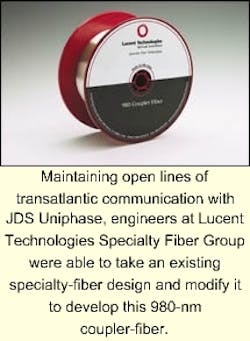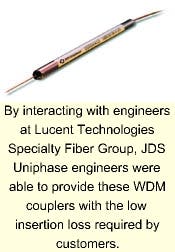Evaluating international partnerships
Corporate relationships that work an ocean apart
BY CATHY CIARDIELLO,
Lucent Technologies Specialty Fiber Group
As the world economy moves increasingly to a global realm as the "norm" for doing business, it is worthwhile to become educated in new modes of doing research and development, manufacturing, and marketing/selling on such a basis. One key to success stems from the very business most of us are in: technology advances that further the communications infrastructure.
Advances in communications technology allow international engineering teams to collaborate and create leading-edge products faster and easier than ever before. By communicating efficiently across the Atlantic, Lucent Technologies Specialty Fiber Group (Avon, CT) and JDS Uniphase (Devon, UK) developed a highly effective working relationship about a decade ago that continues today.
In an effort to assist a customer with a product development problem, an international fiber-optics distributor paired SIFAM Ltd. (acquired by JDS Uniphase in December 1999) with SpecTran Specialty Optics Co. (acquired by Lucent in February 2000). JDS Uniphase was seeking a specialty fiber solution it could incorporate into fused-fiber components for optical amplifiers. The specialized fiber had to meet strict specifications: low bend loss, specific cutoff wavelength, tight core/clad tolerance, and reliable high-proof testing. In addition, once a final design was approved, JDS Uniphase required high-volume manufacturing capacity, with a rapid production schedule.The distributor that made the "match" was already familiar with Lucent's technical expertise and approached the company with JDS Uniphase's product specifications, which helped open a line of communication between the two companies. After meeting with JDS Uniphase's team to get a full understanding of the company's requirements, Lucent engineers were able to take an existing specialty-fiber design and modify it to successfully develop a 980-nm coupler-fiber that met JDS Uniphase's needs.
By fine-tuning the preform design and fiber draw characteristics, Lucent produced the fiber that allowed JDS Uniphase to couple light with a high degree of control into the fiber's cladding, enabling high-quality, repeatable, fused-fiber tapers. This fine-tuning also permitted JDS Uniphase to incorporate into the design something the company had not requested originally-improved core-expansion splicing techniques.
The final fiber design was the result of an ongoing interactive process between the engineers in Devon and Avon. The success of this interaction allowed JDS Uniphase to provide high-quality WDM couplers with the low insertion loss required by its customers.
The process sounds relatively simple. And thanks to modern communications technology, it was simple. The immediate benefits of this international cooperative effort were easy to recognize: JDS Uniphase enhanced its product offering and satisfied customers' needs; Lucent gained a valuable customer in the growing telecommunications market.
Indeed, companies that choose to work with colleagues abroad can enjoy many benefits. Today, there is a shortage of engineers with strong fiber-optic experience. It is therefore advantageous for companies to work jointly, sharing engineering knowledge and expertise. Instead of spending excess time and money trying to develop a highly specialized fiber, JDS Uniphase took advantage of Lucent's specialty-fiber expertise. As a result, JDS Uniphase was able to bring its product to market faster and with less cost.
But the advantages worked both ways. On the other side of the Atlantic, SpecTran, before being acquired by Lucent, was an emerging fiber-optic company that served many markets: industrial, medical, transportation, and geophysical. When the company teamed up with JDS Uniphase, it was able to expand its knowledge and skill set in developing specialty fiber for the soon-to-boom telecom market.
Finding an appropriate collaborator is probably the greatest challenge. In the case of Lucent and JDS Uniphase, a distributor played a key matchmaking role. JDS Uniphase approached its distributor with the fiber specs required and asked for help. Aware that Lucent already had the necessary skill set, the distributor was able to provide JDS Uniphase with a collaborator that met its needs.
Once Lucent and JDS Uniphase recognized the advantages each brought to the table and the value of working in tandem, the second challenge was to integrate their technologies. JDS Uniphase was creating a new product and had very specific ideas about what its performance characteristics should be. Lucent engineers needed to understand the nature of JDS Uniphase's application to determine if an existing specialty fiber could be used. They also needed to understand the technology behind the JDS Uniphase product, the performance requirements, and the ways in which customers would use the product. It took several months for the two teams to become fully versed in each other's technology, processes, and time requirements to come up with a working solution.
When companies on opposite sides of an ocean begin working together, distance and time differences can cause challenges, particularly when those involved have never operated on such a basis. The first hurdle is to "think" across multiple time zones and establish an effective means of working together.
In the case of Lucent and JDS Uniphase, five hours separated Lucent on the eastern U.S. coast from Devon, UK, leaving four mutual work hours in which the two teams could hold real-time discussions. The distributor played a major role in eliminating hurdles. Located in the same time zone as JDS Uniphase, the distributor served as an extension to the Connecticut-based Lucent team. By coordinating efforts between the two companies, the distributor enabled the companies to work more efficiently, helping both parties to gather needed information and passing it on in a timely fashion. Though this technique helped bolster efficiency, it was not an essential part of the transatlantic working relationship.Language barriers can also be challenging when working on a global basis. In the case of JDS Uniphase's British English versus Lucent's American English, there obviously are not many problems. However, language is a serious consideration when working with a company located in a country whose language is entirely different. While English has been informally adopted as the standard language for business, and very often provides a common basis for discussion, not every employee of every company is bilingual. Therefore, a multilingual workforce, especially as the global economy evolves, can prove a strong asset to any company. Besides improved communications, multilingual employees can offer insight into other countries' cultures-successful businesses are sensitive to cultural differences.
Another fact of life in technology development is that different countries may use different systems of measurement. That is one of those "obvious" statements that may seem inconsequential until the first time a company stumbles upon it and discovers the financial cost of making an error can be high.
Import/export issues are also important. Since Lucent already had an established protocol for handling international trade, in working with JDS Uniphase, there were no difficulties shipping product to England. But companies that consider trading internationally for the first time should conduct research and get a strong grasp of international trade regulations before sending even a product sample. Shipping/receiving and sales teams must be up to speed on international trade policies. All of the companies involved must also have the proper licenses to import or export goods. Careful study of the requirements on import and export duties is also a necessity.
Another consideration, for which a company's finance department can provide guidance, is currency exchange rates. Here again, in the case of Lucent and JDS Uniphase, the distributor played an important role by managing the foreign-currency risk for both companies. In this particular case, the distributor purchased Lucent fiber in U.S. dollars and resold it to JDS Uniphase in British sterling.
The potential challenges in international cooperative efforts in product development and trade may sound a bit overwhelming, especially if a company is starting out fresh, but these key factors and issues can be minimized with knowledge, preparation, and most important, good communication between the companies.
As Lucent and JDS Uniphase developed a relationship, both companies found accessibility to be an important factor and opened their facilities to allow for an exchange of technology and information. To guarantee mutual success, all questions pertaining to a project had to be answered fully and honestly, and both companies were required to trust in each other during confidential discussions. That, of course, requires choosing associates wisely, so there's strong mutual advantage to the work. Judicious use of nondisclosure agreements, as appropriate, to protect both parties is also wise.
The joint efforts in product development between JDS Uniphase and Lucent have continued to grow over time. Today, both companies enjoy a dynamic relationship. Based on a full understanding of each other's product lines, Lucent delivers a broad range of specialty-fiber solutions to JDS Uniphase, and in turn, JDS Uniphase sells some of its manufactured components to Lucent. As technological demands change, which is where this story began, Lucent is in a position to continue to keep pace with JDS Uniphase's needs, thanks to a strong transatlantic working relationship.
Advancing technology will continue to help companies overcome the time and distance barriers that used to complicate international relationships-and will enable these businesses to quickly respond to worldwide customer needs. Accordingly, perhaps the most positive outcome of the Lucent-JDS Uniphase relationship is that working together, both companies have created some of the products and technologies that now make it easier for other companies to forge similar relationships.
Cathy Ciardiello is product-development manager at Lucent Technologies Specialty Fiber Group (Avon, CT). She can be reached at [email protected].


